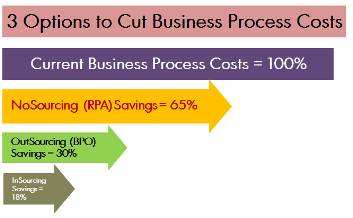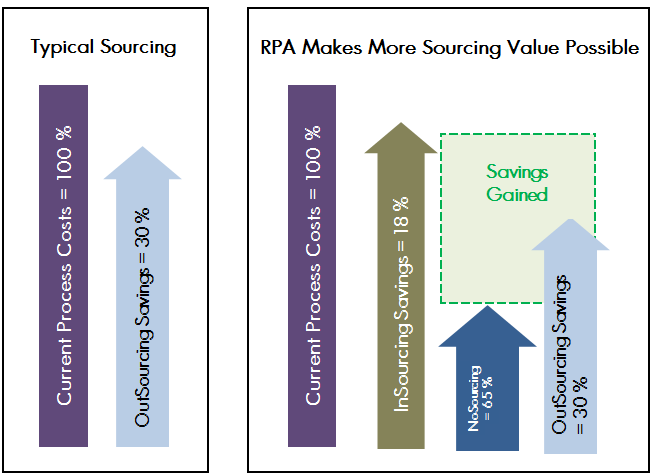BPO has a New Partner – Robotic Process Automation
Share at:

There’s been a lot of discussion about how robotic process automation software and its ability to automate business processes will – or won’t - radically impact business process outsourcing (BPO) providers. Certainly providers won’t disappear. However, when it comes to enabling more sourcing choices and creating greater overall savings, process automation tips the playing field in favor of the business customer.
Since offshore delivery came on the scene in the mid to late nineties, there’s been one sourcing choice: take a IT support function or business process activity out of a company and into a provider’s global delivery framework. Risky (in the early days, even a bit crazy) as it seemed in the beginning, the cost difference between onsite and offshore labor was so great (around a $50/hr. differential) that the financial upside made it an attractive choice.
As outsourcing providers matured their delivery models the risk went down, offshore capabilities increased and the phrase “your mess for less” sprang into being. At the same time, greater competition meant providers could no longer rely just on labor arbitrage to maintain operating margins. In response, they focused on leveraging process efficiencies and productivity gains to compensate for the lower labor differentials.
Of course, customers also had the ability to pursue those same process efficiencies themselves, but the attractiveness of simply handing off those operational challenges to an outsourcing provider – and realizing immediate cost reductions besides - generally made the decision very easy. Now, however, the emerging technology of robotic process automation (RPA) changes the dynamics of those decisions by introducing what could accurately be termed “NoSourcing”.
In the context of RPA, automation means handling business process activities by configuring robotic software so as to mimic the actions of employees who formerly performed those tasks. The term NoSourcing describes a critical differentiator from outsourcing. The work isn’t shifted by a BPO provider to workers in a less expensive location. Instead, the robotic software literally performs the work in a virtual location and makes employees unnecessary. This process automation is almost instantly scalable, completely accurate, and consistently delivers cost savings of up to 65%.

Just as huge labor savings opened the door of opportunity for pioneering outsourcing providers, equally dramatic savings possibilities are causing businesses to give robotic process automation a serious look. As they do so, companies realize analyzing existing processes is the key to clearly defining the technology’s potential for their particular circumstances.
Only by gaining an true understanding of existing processes can gains from centralization, standardization and optimization be accurately forecasted. Prior to robotic software, an InSourcing investment rarely showed sufficient returns against the “mess for less” alternative to win management support. Now, a combination of InSourcing and NoSourcing often makes a compelling argument.

While InSourcing and NoSourcing may be a powerful combination, there are limits to the scope of processes which can benefit from their

respective capabilities. InSourcing - unequalled by either automation or outsourcing when it comes to benefits of business process innovation and marketplace adaptability – cannot beat either in lower predictable costs and scalability. NoSourcing - unequalled by outsourcing in low costs, risk, and scalability – cannot match its range of qualified processes. RPA only automates highly repetitive, rules-driven, processes. Outsourcing has no such restriction.
However, by automating business processes and enabling high returns on an Insourced investment, robotic software makes it possible for business customers to create highly focused and effective sourcing combinations. These combinations place sourcing choices where their strengths are maximized and their weaknesses are either minimized or avoided completely. As a result, the greatest possible savings from all sourcing choices can be achieved.

Strategic Advisor, Tquila Automation
Get articles from automation experts in your inbox
SubscribeGet articles from automation experts in your inbox
Sign up today and we'll email you the newest articles every week.
Thank you for subscribing!
Thank you for subscribing! Each week, we'll send the best automation blog posts straight to your inbox.



